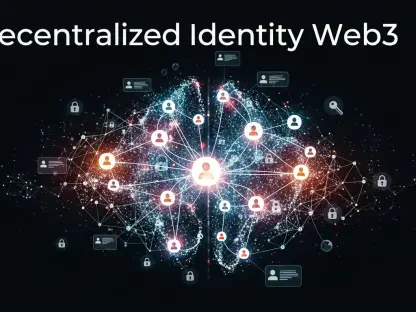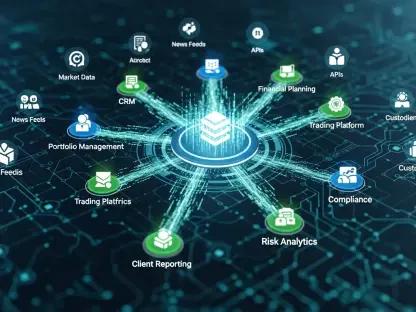What if the trillion-dollar financial markets could be reimagined on a blockchain, with assets like stocks and bonds traded as digital tokens in real time? This isn’t a distant dream but a rapidly emerging reality, and Grayscale, a titan in asset management, has placed Chainlink at the heart of this transformation. With tokenized finance gaining traction among banks and investors, Chainlink’s technology is being hailed as the critical infrastructure to make this vision scalable and secure. This deep dive explores why this blockchain solution is turning heads and how it could redefine the future of global finance.
Why Tokenized Finance Is Making Waves
Tokenized finance, the conversion of traditional assets into blockchain-based digital tokens, has exploded into a $35 billion market as of today. This staggering growth, though still just a sliver—0.01%—of global fixed income and equity securities, signals a seismic shift in how value is stored and transferred. Financial giants are racing to harness blockchain for its promise of efficiency, transparency, and round-the-clock accessibility, yet they face a steep challenge: integrating legacy systems with cutting-edge technology.
The stakes are high. Inefficiencies in traditional markets cost billions annually in delays and intermediaries, and tokenized assets offer a way to streamline these processes. Grayscale’s latest research points to this urgency, emphasizing that the industry needs robust solutions to bridge these worlds. Without reliable infrastructure, the potential of tokenization risks being stifled by mistrust and technical roadblocks, setting the stage for a game-changer to step in.
Unpacking the Challenges of Tokenized Growth
Despite its promise, tokenized finance is grappling with significant growing pains. Interoperability between disparate blockchain networks remains a hurdle, as does ensuring that real-world data feeding into these systems is accurate and tamper-proof. For asset managers and banks, the lack of trust in decentralized systems poses a barrier to adoption, especially when dealing with high-value transactions.
Moreover, regulatory uncertainty looms large. Governments and financial bodies worldwide are still crafting frameworks for tokenized assets, leaving institutions cautious about diving in. Grayscale’s analysis underscores that while the market has surged in recent years, its small share of global capital markets highlights just how much room there is to grow—if these foundational issues can be addressed with dependable technology.
Chainlink’s Pivotal Role in the Revolution
Enter Chainlink, a blockchain middleware often described as the missing link between traditional finance and decentralized systems. Grayscale’s report praises its oracles, which pull real-world data like stock prices into smart contracts, ensuring that digital transactions reflect accurate market conditions. This capability has already made Chainlink a cornerstone of decentralized finance, powering billions in transactions.
Beyond data feeds, Chainlink’s Cross-Chain Interoperability Protocol (CCIP) stands out as a breakthrough. A pilot with J.P. Morgan’s Kinexys platform and Ondo Finance showcased how CCIP enables seamless token transfers across blockchains, a vital step for tokenized assets to scale. Coupled with compliance tools and alliances with data giants like S&P Global, Chainlink is positioned as a trusted conduit for bringing Wall Street onto the blockchain.
The LINK token itself adds another layer of intrigue for investors. Grayscale frames it as a unique opportunity to invest in the infrastructure underpinning crypto’s merger with mainstream markets. Unlike speculative cryptocurrencies, LINK offers exposure to a utility-driven ecosystem, making it a compelling asset in the tokenized finance narrative.
Grayscale’s Bold Bet on Chainlink
Grayscale isn’t just theorizing about Chainlink’s potential; it’s taking action with a filing to convert its $29 million Chainlink Trust into a U.S.-listed ETF under the ticker GLNK on NYSE Arca. This proposed fund, which includes a staking component, could be a first of its kind, reflecting a growing appetite among institutional investors for regulated crypto products. Such a move signals deep confidence in Chainlink’s staying power.
Industry sentiment aligns with this perspective. Asset managers increasingly view blockchain as a transformative force, and infrastructure providers like Chainlink are seen as the bedrock of this shift. Grayscale’s report leans on concrete evidence, from tokenized market expansion to Chainlink’s real-world applications, avoiding hype in favor of a measured, data-driven outlook that resonates with cautious yet curious financial players.
This ETF filing also mirrors a broader trend. As institutional demand for crypto exposure grows, regulated vehicles like ETFs provide a safer entry point, potentially accelerating adoption. If approved, GLNK could democratize access to Chainlink’s ecosystem, marking a pivotal moment for tokenized finance’s mainstream journey.
Chainlink in the Investor’s Playbook
For investors and institutions eyeing this space, tokenized finance represents a trend that cannot be ignored. Grayscale’s insights offer a practical roadmap: start by monitoring the market’s trajectory, as its rapid growth hints at significant impacts on future portfolios. Understanding the role of enabling technologies is crucial for staying ahead of the curve.
Chainlink, in particular, emerges as a diversified investment avenue. Whether through direct ownership of LINK or potential vehicles like the proposed ETF, exposure to this infrastructure taps into the broader evolution of finance. It’s not about betting on a single blockchain but supporting the backbone of an emerging digital economy, a perspective that broadens its appeal.
Regulatory developments warrant close attention as well. Approval of products like GLNK could lower barriers, allowing more players to participate without wrestling with the technical intricacies of crypto. This evolving landscape suggests that staying informed and agile will be key for anyone looking to navigate the tokenized frontier effectively.
Reflecting on a Transformative Shift
Looking back, the spotlight on Chainlink by Grayscale marked a defining chapter in the tokenized finance saga. The recognition of its oracles, interoperability protocols, and strategic partnerships underscored a critical truth: bridging traditional and blockchain systems demanded robust, trusted solutions. The $35 billion tokenized market, though nascent, hinted at a colossal potential that captured the imagination of financial innovators.
As discussions unfolded, actionable steps emerged for stakeholders. Keeping abreast of regulatory shifts that could unlock broader access remained essential, as did exploring investment in infrastructure like Chainlink to gain a foothold in this space. Engaging with pilot programs and industry collaborations offered a tangible way to witness tokenization’s impact firsthand.
Beyond immediate actions, the journey pointed toward a larger horizon. Continued innovation in blockchain integration promised to address lingering challenges, paving the way for a financial ecosystem where digital assets could rival their traditional counterparts. This evolving narrative left an indelible mark, urging all to ponder how deeply technology could reshape the very fabric of global markets.









